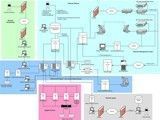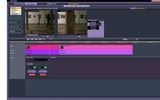
-
StatusCompleted
-
Status date2014-12-09
Project Indigo is a series of application developments in the broadcast application market, designed to stimulate the use of satellite space segment by developing broadcast applications for the TV industry. This suite of developments has been led in the UK by Arqiva Ltd (formerly Kingston Inmedia) as part of an ARTES-4 contract 18508/04/NL/US.
During 2004-5, Project Indigo developed five sub-systems: Remote Ingest, Remote Scheduling, Remote Playout and Development (RPAD), Digital Archive and Enhanced Playout which could then be offered together. This project concluded in December 2005.
Unified architecture for Indigo Phase 2 Stage 1 developments
Project Indigo Broadcast and Workflow Tools
The original proposal for Indigo Broadcast and Workflow Tools (BWFT), the last product set in the Indigo family, was made to ESA in the summer of 2006. By request of ESA, the development was divided into two sub-Phases. Sub-Phase 2.1, which was completed in the autumn of 2006, dealt with the User Requirements and System Architecture of the system. The go-ahead was then given for Sub-Phase 2.2, which started in January 2007, which kicked off the technical development.
The Workflow and Broadcast Tools product allows broadcasters to improve efficiency and reduce costs by digitising content and providing a number of significant production benefits, before the transmission process.
Content is moved from Arqiva to the broadcaster and third-party Facilities Houses in high or low-resolution versions in order to edit the material, or for the production of promotions, subtitles and audio tracks. By reducing the need for tapes, the process is speeded up dramatically, cutting the time for acquiring material to air from three months to three weeks or even less.
The system is targeted at broadcasters, who have multiple channels in multiple territories, as these will benefit most from the way the Workflow system works. Multiple territories often mean multiple languages, and subtitle and audio files can be sent by email, rather than burning them onto tapes to be couriered.
The key issues with Project Indigo Phase 2 Stage 2 were:
- To ensure that all new systems could interface with existing ones, whilst at the same time ensuring they were adequately resourced and that operational staff were properly trained prior to their deployment,
- To ensure that the system development supplier was managed effectively to deliver to the development contract requirements,
- To ensure that delivery timescales were tracked to enable Arqiva operational resources to be scheduled to a changing timescale.
Mediaflex Compliance Shot Selector interface
Delays were encountered in the project build when the system development supplier was late in the delivery of their contracted project phases. This led to the delay in Acceptance Tests for each project phase (in the end these had to be phased over a period of 12 months) and a subsequent delay in the Trials (early 2009) and Final Report stages (March-April 2009).
The main benefits of the system are as follows:
- Much greater ease in repurposing content for different distribution platforms,
- Wider audiences leading to increased revenue possibilities,
- Predictable efficiencies in broadcast workflow,
- Greater control and visibility of the workflows,
- Economies of scale in content distribution,
- Time to air is reduced – typically the estimated reduction in time in bringing new content to air is down from 3 months to 3 weeks or less,
- Cost reductions eg in reducing the need for tape in manipulation and storage of content,
- New channels or workflows are easier to add.
Arqiva’s Workflow system provides core functionality for:
- Metadata management for the information associated with media content,
- Library management for physical based media content such as tapes,
- Ingest management for the digitisation of media content, whether on tapes or files,
- Storage management for the holding and movement of file based media content,
- Archive management for the long term storage of file based media content,
- Workflow management for the business processes associated with media content.
In addition to the core functions the system provides customers with a media management solution that covers the following.
Ingest and QC
Content is ingested from tape, file or lines. At ingest, both a high resolution and low resolution ‘browse’ copies are made of the content and stored on the system. Using the Workflow system, automated and human checks can be made on the technical quality of the content.
Desktop browse and shot selection
The Workflow system give the ability for users to browse all assets frame accurately in low resolution. Users are also able from the browse copies to mark up shots for activities such as content QC, shot selection for promo production and create Edit Decision Lists to be used by craft editors.
Additional audio language tracks
The browse version of content can be provided to Audio houses for use in preparing language tracks. The resulting audio files are then associated to the correct media by the Workflow system.
Subtitling
The browse version of content can be provided to Subtitling houses for use in preparing subtitles. The resulting subtitle files are then associated to the correct media by the Workflow system.
Transcode and re-purposing
The Workflow system manages transcoding of media items from one format to another.
Playout and distribution
The Workflow system is integrated with the Playout system. Content ready for transmission is kept in appropriate storage until required for transmission. After transmission, content is stored until required again or deleted based on a defined rule-set.
Trials took place in early 2009. They showed that Workflow is well understood and its benefits appreciated. Technical product developments will be reviewed against future likely extra revenue and prioritised accordingly.
Arqiva will therefore pay particular attention during the roll-out of new services to the risks and issues posed by integrating to existing technology and rolling out workflow processes into third party suppliers. New services are now being bid which rely heavily on the new functionality offered by Workflow and Broadcast Tools, including one multi-million Euro contract with a large channel owner. It would have been impossible for Arqiva Satellite and Media to bid for this project had Workflow not been developed.
On the international scene, Arqiva Satellite and Media Solutions is well positioned to penetrate further markets, especially because of the ‘re-versioning’ features of the Workflow and Broadcast Tools system. This capability (the ability to produce at low cost different regional or language versions of the same broadcast material) is of great interest to large customers who will have further reason to choose the UK and Europe as the best location from which to operate multi-channel satellite TV channels.





